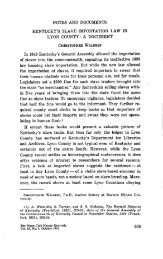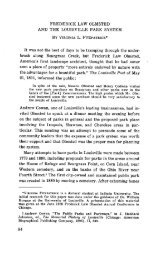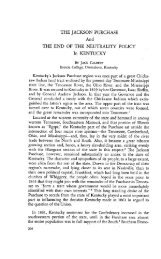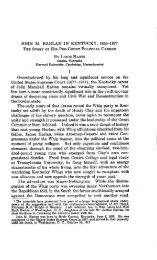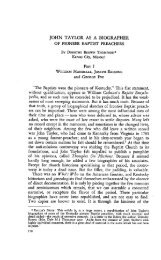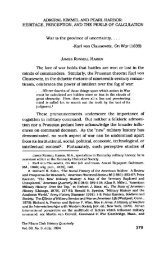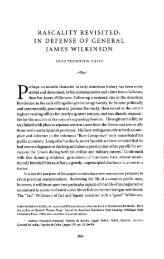Eskippakithiki, The Last Indian Town in Kentucky - The Filson ...
Eskippakithiki, The Last Indian Town in Kentucky - The Filson ...
Eskippakithiki, The Last Indian Town in Kentucky - The Filson ...
You also want an ePaper? Increase the reach of your titles
YUMPU automatically turns print PDFs into web optimized ePapers that Google loves.
Vol. 6 ] <strong>The</strong> Fdson Club History Quarterly 359<br />
opposition to the white advance, which was a longer time than the<br />
opposition of any other <strong>Indian</strong> people except the Iroquois. Hav<strong>in</strong>g<br />
no European arms <strong>in</strong> the seventeenth century, they were compelled<br />
to flee from the well-armed Iroquois. Some fled to the<br />
Miamis, north of the Ohio, unit<strong>in</strong>g with them aga<strong>in</strong>st the common<br />
enemy and w<strong>in</strong>n<strong>in</strong>g for both swift Iroquoian vengeance;<br />
others fled along the Warriors' Path, through the Cumberland<br />
Gap, to the Spanish <strong>in</strong> Florida. LaSalle <strong>in</strong>vited the few left <strong>in</strong><br />
<strong>Kentucky</strong> to come to Ill<strong>in</strong>ois, where he built Fort St. Louis, <strong>in</strong><br />
1681, for their protection. <strong>The</strong>re some of the Shawnees built a<br />
new Chaskepe, and became children of Louis XIV, K<strong>in</strong>g of<br />
France, and were <strong>in</strong>oculated with sympathies which governed<br />
much of the subsequent Shawnee history. S<strong>in</strong>ce then, with the<br />
exception of <strong>Eskippakithiki</strong>, a few houses opposite Lower Shawnee<br />
<strong>Town</strong> at the mouth of the Scioto, and a temporary village or<br />
two, there have been no <strong>Indian</strong> residents <strong>in</strong> <strong>Kentucky</strong>.*<br />
THE SHAWNEES IN CAROLINA: <strong>The</strong>'Warriors' Path or Trace<br />
crossed the Ohio River at the mouth of Cab<strong>in</strong> Creek <strong>in</strong> Mason<br />
County, <strong>Kentucky</strong>, below the mouth of the Scioto, where Portsmouth,<br />
Ohio, now stands. This Trace ran to the Upper Blue<br />
Licks, <strong>in</strong> Flem<strong>in</strong>g County; thence to <strong>Eskippakithiki</strong>, which the<br />
white settlers later renamed <strong>Indian</strong> Old Fields, <strong>in</strong> Clark County;<br />
thence up Station Camp Creek, <strong>in</strong> Estill County, to the Pictured<br />
Caves at its head near the mouth of Red Lick Creek; thence<br />
through the low hills of Jackson County to the Flat Lick near<br />
Barbourville, <strong>in</strong> Knox County; and thence out of <strong>Kentucky</strong><br />
through Cumberland Gap: and along tl e back border of the Carol<strong>in</strong>as<br />
to the Spanish settlements <strong>in</strong> Georgia and Florida. This was<br />
from prehistoric times a major trade route down which went copper,<br />
northern furs, and glacial pebbles for mak<strong>in</strong>g stone axes; and<br />
up which came sea-shells, southern plumage, and mica.<br />
Georgia, at the time this story beg<strong>in</strong>s, had not been settled by<br />
the English and was considered a part of Florida, the Spanish hav<strong>in</strong>g<br />
settlements on the coast and gold m<strong>in</strong>es <strong>in</strong> the <strong>in</strong>terior. Upon<br />
the southern end of this Trace the Shawnees--or Savannahs as<br />
they were there called--bnilt their towns, on the waters of the Savannah<br />
River, from whence they robbed the Spanish and traded<br />
with the South Carol<strong>in</strong>a English for the firearms and edged tools<br />
which had become so necessary for their existence. Rich <strong>in</strong> per-



